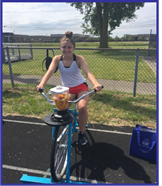 Obesity is a national epidemic. In the past 40 years, obesity rates have nearly quadrupled among youth in the United States. Currently, 19.3% of U.S. youth, aged 2-19 years, are obese (Fryar et al., 2020). Childhood obesity and cardiovascular risk factors can lead to severe long-term health risks, including diabetes and heart disease (Bray et al., 2004; Jacobs et al., 2022). Project Healthy Schools (PHS) is a community-university collaborative that aims to curb poor lifestyle habits developed in childhood. The program encourages healthy habits through education and environmental change (Rogers et al., 2017).
Obesity is a national epidemic. In the past 40 years, obesity rates have nearly quadrupled among youth in the United States. Currently, 19.3% of U.S. youth, aged 2-19 years, are obese (Fryar et al., 2020). Childhood obesity and cardiovascular risk factors can lead to severe long-term health risks, including diabetes and heart disease (Bray et al., 2004; Jacobs et al., 2022). Project Healthy Schools (PHS) is a community-university collaborative that aims to curb poor lifestyle habits developed in childhood. The program encourages healthy habits through education and environmental change (Rogers et al., 2017).
PHS has five main goals: (1) eat more fruits and vegetables, (2) choose less sugary foods and beverages, (3) eat less fast and fatty foods, (4) be active every day, and (5) spend less time in front of a screen. These goals are promoted through ten standardized, interactive lessons. PHS also works with school policy-makers to change vending machine and cafeteria food options, set up after-school activity programs, host field days, and coordinate many other environmental changes. Recent additions to the PHS curriculum include lessons on infectious disease (motivated, in part, by the COVID-19 pandemic), vaping, and kidney health.
 In 2004, PHS was piloted at Clague Middle School in Ann Arbor. The program spread to five additional Ann Arbor middle schools by 2006. Through the help of many donors, PHS has being implemented in over 140 Michigan schools, including schools in rural and low-income communities, and is expanding to other states and internationally.
In 2004, PHS was piloted at Clague Middle School in Ann Arbor. The program spread to five additional Ann Arbor middle schools by 2006. Through the help of many donors, PHS has being implemented in over 140 Michigan schools, including schools in rural and low-income communities, and is expanding to other states and internationally.
To date, behavioral survey data from over 26,700 students and physiological data from over 3,100 students has been collected. With this continuously growing dataset, PHS has published 19 manuscripts and over 65 abstracts. This research has primarily focused on the program’s effectiveness, and the resulting publications have demonstrated immediate and lasting improvements in participants’ health. These improvements include decreased total cholesterol, LDL cholesterol, triglycerides, and blood pressure, as well as increased physical activity and decreased sedentary behaviors.
In Fall 2022, new data variables were added to the health behavior survey to reflect current issues affecting middle school children: sleep quality, school safety, social-emotional learning, water and caffeinated beverage consumption, vaping, food insecurity, and the effects of the COVID-19 pandemic. In addition, the PHS team is working closely with a team from the NIH to determine effects of the COVID-19 pandemic on school meal distribution and access.